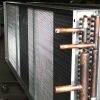The time has finally come. After many long years serving as the building’s workhorse, your AHU fan finally gave up the ghost and broke down. It looks like this time it is for good.
When it is time to replace your AHU fan system, there are many factors to consider. After all, you want this new AHU fan to move air effectively and efficiently, and of course, stand the test of time.
One important factor to consider is whether to use an AC motor-powered fan system or an EC motor-powered fan system. They both are well known in the HVAC industry for being effective solutions, but which will you choose? Most everyone knows that AC motors consume more power than EC motors if both are moving the same amount of air, but there are other differences too.

One major difference between AC and EC motors is related to their respective bearing operating lives. Let’s take a deeper dive into this subject to understand more fully why this factor is an important consideration when selecting a fan array system for your refurbished AHU.
How to Measure Bearing Life
The first thing to understand when comparing the bearing lives of two different motor technologies is how bearing lives are expressed. Historically there were four ways to express the measurement of bearing life:
B10 or L10 and B50 and L50
Over time most of these fell out of use. This is primarily because B10 and L10, and B50 and .L50, had the same meaning. The preferred term is now L10, but L50 is still sometimes used, so it is important to understand these terms.
L10 life is the preferred term for bearing life and is also known as Basic Rating Life. It represents the period of time, usually hours, where a failure rate of 10% or less is expected for a group of identical bearings. In other words, it expresses that 90% of bearings will not have developed metal fatigue after a certain amount of time. L10 life is also known as the “minimum expected life” of a bearing.
L50 life represents the period of time where a failure rate of 50% is expected for a group of identical bearings. In other words, it expresses that 50% of bearings will not have developed metal fatigue after a certain amount of time. L50 life is also known as the “average life” of a bearing.

L10 and L50 Equivalents
L10 and L50 are related. L50 equals fives times L10. The below chart highlights this relationship.

How High of a Score Do You Need?
It is important to consider the big picture when analyzing and comparing motors’ L10 and L50 ratings. For example, if a motor has a L10 rating greater than 200,000 hours, it is assumed that the motors will fail for reasons other than the bearings. Think about it. There are 8760 hours in a year, so an L10 of 200,000 hours translates to a minimum expectation of 22 years of continuous operation.
Important Consideration
Bearing life is calculated from dynamic capacity, bearing load and RPM. For this reason, motors do not have a nominal rated bearing life. It depends on the operating conditions.
Furthermore, the “installed life” of the bearing will depend on the application and maintenance. Proper lubrication, minimization of shock and vibration, alignment, presence of debris, temperature, and other factors all play a tangible role in the bearing installed life.
How Things Stack Up
External rotor motors like most EC motors, have benefits including shorter physical size and reduced power consumption, however, L10 bearing life is commonly only 30,000-40,000 hours which translates to 3 – 4 years.
Motors with an internal shaft, such as AC motors with the traditional NEMA frame design, normally have an L10 life of 100,000 – 200,000 hours. So they can be expected to last decades, and rarely fail due to bearing material fatigue.


So What Does This Mean for Permanent Magnet Synchronous Reluctance Motors?
The best of both worlds! EC motor energy efficiency benefits with AC motor bearing life.
One of the major benefits of permanent magnet synchronous reluctance motors is that their bearing life is comparable to that of AC motors due to them having an internal shaft.
Not only do you get all of the energy efficiency benefits of EC motors with permanent magnet synchronous reluctance motors but you also get the benefits of longevity associated with AC motors.
AC motors and permanent magnet synchronous reluctance motors have another thing in common. They are both readily available and do not utilize rare Earth materials like EC motors.
What does this mean for you? You can have a fan system up and running in just a few months. With EC motors you might have to wait a year.
Packaged in a familiar form factor, PMEC motors voters are beloved by engineers and building owners alike. Easy to operate, easy to maintain, high efficiency, quiet, and small enough to fit through doorways and elevators. What more could you ask for?
If you want to learn more about bearing life and how it applies to your application or have any other questions about EC motors PMEC motors or AC motors contact our team. We’re happy to help answer questions and put together a proposal for you.




